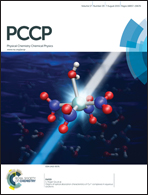Structural, electronic and energetic consequences of epigenetic cytosine modifications†
Abstract
The hydrogen bonding patterns of cytosine and its seven C5-modifed analogues paired with canonical guanine were studied using the first principle approach. Both global minima and biologically relevant conformations were studied. The former resulted from full gradient geometry optimizations of hydrogen bonded pairs, while the latter were obtained based on 125 d(GpC) dinucleotides found in the PDB database. The obtained energetic, electronic and structural data lead to the conclusion that the epigenetically relevant modification of cytosine may have serious consequences on hydrogen bonding with guanine. First of all, the significant substituent effects were observed for such trends as charges on sites involved in hydrogen bonding, the total intermolecular interaction energy or electron densities at bond critical points. Moreover, the molecular orbital polarization contribution resulting from energy decomposition expressed in terms of absolutely localized molecular orbitals exhibited an inverse linear correlation with frozen density contributions. A substituent effect on the amount of charge transfer from pyrimidine toward guanine was also observed. The increase of intermolecular interactions of guanine with modified cytosine is associated with the increase of the electro-donating character of the C5-substituent. However, only pairs involving 5-methylcytosine are more stable than those formed by canonical cytosine. Furthermore, the energy differences observed for global minima also remain important for a broad range of displacement and angular parameters defining pair conformations in model d(GpC) dinucleotides. Due to the sensitivities of intermolecular interactions to mutual arrangements of monomers the modification of cytosine at the C5 site can significantly alter the actual energy profiles. Consequently, it may be anticipated that the modified dinucleotides will adopt different conformations than a standard G–C pair in a B-DNA double helix.


 Please wait while we load your content...
Please wait while we load your content...